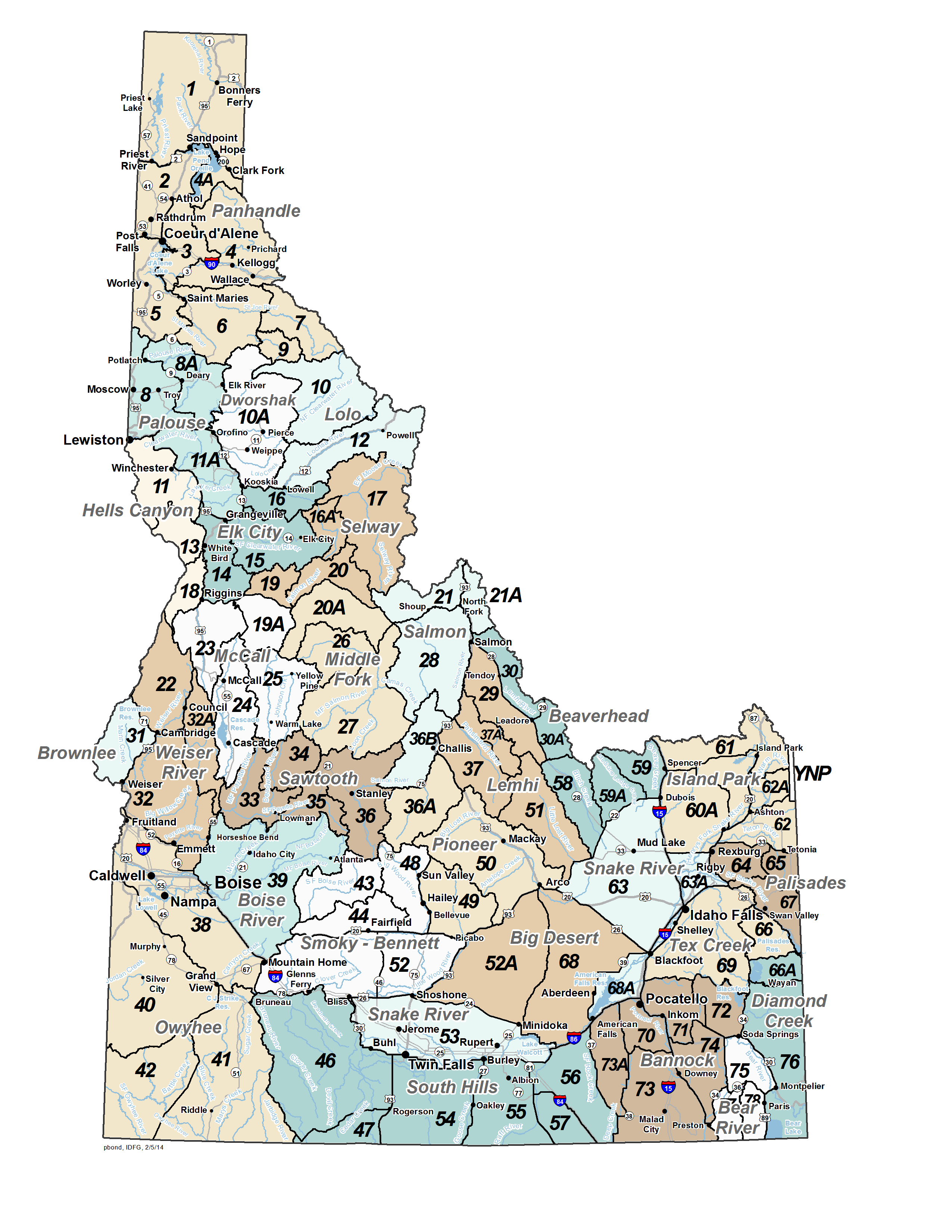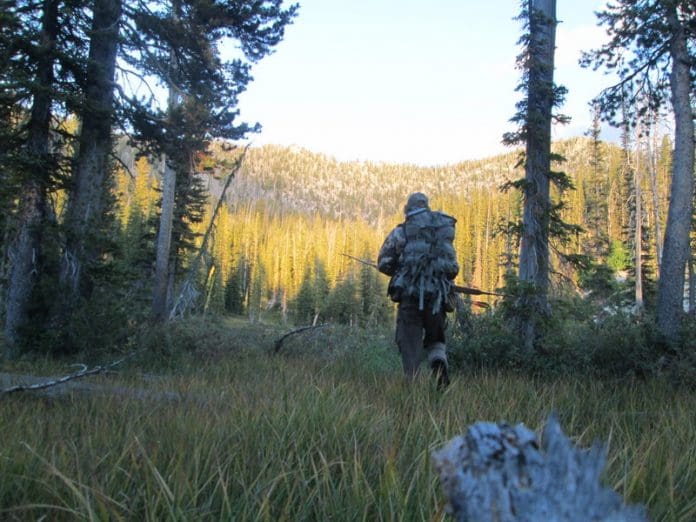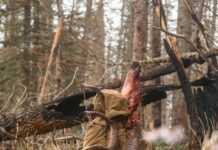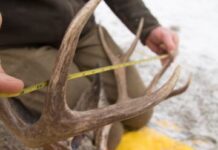Idaho OTC Elk, Part I
By Ron Wright, Rokslide Member
There is an increasing interest in DIY elk hunting in Idaho. With the economy better across the country, elk hunting improving in Idaho, and point creep in other states, there is no reason why this trend won’t continue. I live and hunt in South-central Idaho and will share some personal insight on DIY Idaho elk hunts based on my scouting and hunting experience. This artilce is geared towards helping you narrow down the options, get you started, and give you an idea of what the average hunter can expect.
Overall, for the last twenty years elk populations have been declining in most of Idaho. This decline does parallel wolf reintroduction, but there are other contributing factors and some areas were in decline before re-introduction. However, wolf management is now under state control and things have been starting to improve. Wolves have been here for twenty years now and elk are adapting to them in a lot of areas.
Idaho is divided up into elk zones and zones are subdivided into units. In more than half of the zones, elk are now increasing in numbers and are above population objectives. In other areas, elk numbers are still struggling though. It seems to be proportional to wolf and bear densities, so consider that as a general rule when researching zones to hunt. Zones that are more accessible to hunters and trappers tend to have lower predator densities and better elk numbers, but not always.
Value & Opportunity
When weighing opportunity versus quality versus cost, Idaho is one of the best values there is. Idaho provides lots of opportunity for the money and the bull quality is decent with a chance of being great. The majority of the state offers general seasons, which means licenses are offered over-the-counter (OTC) with unlimited tag numbers for residents and a generous cap for non-residents. This allows you to build elk hunting experience by hunting every year. By hunting OTC every year, when you do finally draw a premium tag, you will be more prepared to get the most out of it. Also there are concurrent seasons for elk/deer and the youth tags are cheap. A hunting license will set you back about $150 and an elk tag will cost about $400 at the time of this writing.
Depending on where you’re coming from, a hunt will set you back as little as $1,000 after gas and food, maybe even less if gas prices remain “low”. For a nonresident, both the deer and the elk tag can also be used for bear, wolf, and mountain lion. Opportunity wise, this is a four-for-the-price-of-one deal, but in the end you can still only harvest one animal per tag. However, if you’re elk hunting and you get that once-in-a lifetime chance on a mountain lion or a shot on a wolf, you have the option to take it in lieu of your elk or deer.
If you’d rather not use your elk or deer tag on a predator, you can pick up predator tags pretty cheap. As of press time, you can also buy a second elk and deer tag in a lot of zones if the nonresident quota has not been met. So if you tag out early there is the option to go to town and buy another tag and recharge with a cheeseburger in some areas (Snowbunny in Hailey and big Judds in Boise are worth the trip when you want a nice greasy burger.) I’m more of an opportunistic hunter so I like to hunt zones with concurrent deer and elk seasons so my chance for meat in the freezer is good. If your goal is just an elk, then the other species will just be a distraction. I’ve been in that situation too.
Bedded bull chewing his cud
What Can I Expect
Idaho is steep, rugged, and predator dense. The elk get pretty educated early in life and can go silent quickly in pressured areas. When hunting OTC public land in Idaho, you can assume the easy ones have been shot or ate already. The rest of the elk pretty much live in the harder to reach areas full time now. Relatively speaking, a draw zone or non-wolf state will probably show you an easier hunt. However, with fortitude and a little bit of effort, you can have great success.
You will be surprised at what you can accomplish in the Rocky Mountains when serenaded with bugling elk. In many of the OTC units, there can be a lot of elk running around and raghorns, spikes, and cows are fairly common with effort. The OTC tags do however limit the number of big bulls in these units, but there are still a few around.
There is a ton of public land in Idaho and a lot of the zones open on the same day; this helps spread out the pressure. There have been many backpack hunts I’ve done where I didn’t see anyone the whole time. This usually happens in the areas with lower animal densities and/or old growth wilderness settings.
Public land bulls like it steep
Quality
From my perspective, the genetics are about the same throughout the state. It’s the ability to reach old age that generates bigger bulls and even the occasional trophy. Idaho is a state managed for opportunity and it’s just simply tough for a bull to reach old age in most OTC units. The research papers and progress reports suggest hunter harvest is the top cause of mortality for older age class bulls. This is the trade off for having unlimited tag archery rut hunts, especially with today’s technology. Idaho’s OTC units are not the places to hunt if you’re a pure trophy hunter. Take a look through the Idaho Big Game Records here and you will see historically this is not a big bull state.
Quality on a consistent basis that us blue collar hunters can expect would be a nice raghorn, 5-point, or small 6-point. A 280-300 bull is a dandy for most of us resident OTC hunters. There is rumor of 350 OTC bulls on a yearly basis and sometimes it’s true.
A small 6-point bull grazes in a burn in an OTC unit
Acquiring the License & Tag
I’m going to have to skip a lot of the details on licensing and keep it general. Idaho is somehow simple, complicated, and confusing all at once. There are publications that do a good job of outlining the licensing and tag system like The Huntin’ Fool and goHunt. You should also read through the Licenses page here and get familiar with the details of the licensing and rules as this article will not cover all the legalities of the hunt.
Hunting licenses, tags, and permits can be purchased online here. The nonresident limited quota tags go on sale December 1st of the previous hunt year. These limited quota tags are not the same as the controlled hunt tags and are on a first come first serve basis. In the last few seasons, tag quotas, (click here) in the limited quota zones have been selling out at a progressively faster rate. Some of these first come first serve tags are even selling out before the draw hunt application periods open in a lot of other states, including Idaho. For example, the nonresident A tag for the Sawtooth zone 2016 tags sold out by the end of December in 2015.
For the OTC elk hunts, which is the focus of this article, there are two classifications of tags in each zone. The A tag and the B tag. The difference between the two are different seasons and weapon restrictions and this varies by elk zone and in some cases each individual hunt unit within an elk zone. This type of tag structure allows flexibility in that you can choose your OTC hunt with the priority based on hunt dates, location, or weapon. For the limited quota tags, both the A tags and the B tags will have separate quotas for the same zone.
Generally speaking the A tags are the Archery hunts and the B tags are the rifle hunts. The archery hunts sit at the apex of opportunity. The A tags are generally for any elk, OTC, unlimited, and during the rut. Some of them, like the Smokey Mountain zone, even have a “Spike Only” any-weapon season after the archery season. So if you strike out during the September archery season, you can come back for an early November rifle meat hunt on the same tag. There is a table in the general elk hunt section of the regulations here that lays out the hunts for each elk zone. Each elk zone is usually made up of multiple individual units. For example, the “McCall” elk zone is comprised of units 19A, 23, 24, 25.

One thing to note is that for archery only tags, you will also have to purchase a separate archery permit along with your elk tag. Completion of an approved bowhunter education course is required in order to purchase an archery permit and Idaho recognizes other states courses. Make sure you have your hunters safety course and bowhunters education certificates taken care of and available before you try to buy tags.
Which OTC Units are the Best?
There some great zones and elk hunts in Idaho and it would be hard to choose just a few. If there was a zone that was that much better than the others, everyone would hunt it anyways and the quality would drop quickly. The OTC season structures on a statewide level self regulate in this context. You can look through the statistics to get an idea of what is being harvested in the zones you’re interested in. I’m still not sure if the statistics shown here are representative of the animals, or of the hunters. You can make a strong case that the success rate is simply just the percentage of hunters that are getting away from the roads and working hard at making it happen. You can also make a strong case that the success rate is heavily dependent on road access. Either way, what you want to get out of the hunt should be the most determining factor in what zone to hunt and what tag to get. Do you want a remote backpack hunt or a nice base camp to day hunt out of? Archery or rifle? Late season or early season? There are advantages and disadvantages to all of the hunts, so stick with what your most prepared for and comfortable with.
With that said, the zones that have tag quotas do seem to offer a little better quality hunting experience than the ones that are unlimited. The limited tag numbers seem to reduce competition and pressure, especially during the archery seasons. The A tag quotas are typically the smallest, so it has the same effect as a draw zone with respect to crowds. I will go out on a limb here and say you get the same hunt quality in terms of crowds but without having to build a few points like in other states for the same experience. The unlimited zones are great too, maybe even better due to higher elk density in a lot of them. In the last two seasons, I have seen two monster elk in my taxidermist’s shop from two different local OTC unlimited zones.
One thing to take note of is that anywhere within about three hours or less of a big city there will be more pressure and competition. This is especially true with the areas that have lots of motorized access. Look for areas that don’t have roads down every canyon and ATV trails along every ridge. It will be a less stressful hunt and you will get into vocal elk easier. Ultimately you will have the best success in an area you are familiar with, and realistically this could take a few seasons.
I initially chose my preferred elk zone based on concurrent elk, deer, bear, wolf, and mountain lion seasons. That way I could hunt whatever I came across. This strategy inherently increases the odds of all around success when you’re in a new area. If your focus is just elk, then there is no advantage to this. I now choose my zones based on scouting, but most nonresidents don’t have that luxury for the first hunt in a new area.
In Part II, I’ll give you my tips for finding elk in the OTC units of Idaho
You can subscribe to this article so you don’t miss Part II or ask Ron questions here



















